Gravitation;
- Books Name
- Science Made Easy Science Book
- Publication
- Science Made Easy
- Course
- CBSE Class 9
- Subject
- Science
Introduction
→ Gravitational Force of Earth: If we release a small stone without pushing it from a height, it accelerates towards earth. Earth attracts everything towards it by an unseen force of attraction. This force of attraction is known as gravitation or gravitational pull
universal law of gravitation
- Books Name
- Science Made Easy Science Book
- Publication
- Science Made Easy
- Course
- CBSE Class 9
- Subject
- Science
Universal Law of Gravitation
→ Sir Isaac Newton in 1687 proposed a law about the force of attraction between the
objects in the universe which is known as Newton’s law of gravitation.
According to Universal law of Gravitation
→ Every mass in this universe attracts every other mass with a force which is directly proportional to
the product of two masses and inversely proportional to the square of the distance between them
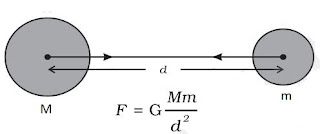
• Let masses (M) and (m) of two objects are distance (d) apart, then force of attraction (F) between
them
F ∝ M×m
F ∝ 1/d2
F ∝ Mm/d2
F = (GMm)/d2
where,
G is a constant and is known as Gravitational constant.
Value of G = 6.67×10-11 Nm2/kg2
G is called universal gravitational constant.
→ If unit of F is in Newton, m is in kg, d is in mere, then unit of G can be calculated as :
G = (F×d2)/Mm, therefor unit will be Nm2/kg2
Importance of universal law of gravitation
(i) The force that binds us to the earth.
(ii) The motion of moon around the earth.
(iii) The motion of earth around the sun.
(iv) The tides due to moon and the sun.
force of gravitation of the earth (gravity)
- Books Name
- Science Made Easy Science Book
- Publication
- Science Made Easy
- Course
- CBSE Class 9
- Subject
- Science
Free fall of an object and acceleration (g)
→ When an object is thrown upward, it reaches certain height, then it starts falling down towar
earth. It is because the earth’s gravitational force exerts on it.
→ This fall under the influence of earth is called ‘free fall of an object’.
→ During this free fall direction do not change but velocity continuously changes which is calle
acceleration due to gravity. It is denoted by ‘g’.
→ Its unit is same as acceleration m/s .
acceleration due to gravity
- Books Name
- Science Made Easy Science Book
- Publication
- Science Made Easy
- Course
- CBSE Class 9
- Subject
- Science
Gravitational Acceleration and its value at the surface of earth
→ The uniform acceleration produced in a freely falling object due to the gravitational force of
earth, is called acceleration due to gravity.
→ It is represented by ‘g’ and it always acts towards the centre of the earth.
Mathematical Expression for g
From the second law of motion, force is the product of mass and acceleration.
F = ma
For free fall, acceleration is replaced by acceleration due to gravity.
Therefore, force becomes:
F = mg ….(i)
But from Universal Law of Gravitation,
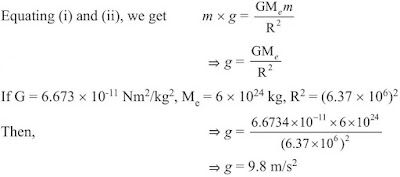
Factors Affecting the Value of g
- As the radius of the earth increases from the poles to the equator, the value of g becomes greater at the poles than at the equator.
- As we go at large heights, value of g decreases.
To Calculate the Value of g
Value of universal gravitational constant, G = 6.7 × 10–11 N m2/ kg2,
Mass of the earth, M = 6 × 1024 kg, and
Radius of the earth, R = 6.4 × 106 m
Putting all these values in equation (iii), we get:
![]()
Thus, the value of acceleration due to gravity of the earth, g = 9.8 m/s2.
Difference between Gravitation Constant (G) and Gravitational Acceleration (g)
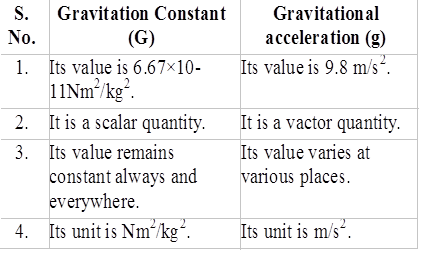
Motion of Objects Under the Influence of Gravitational Force of the Earth
Let an object is falling towards earth with initial velocity u. Let its velocity, under the effect of gravitational acceleration g, changes to v after covering the height h in time t.
Then the three equations of motion can be represented as:
Velocity (v) after t seconds, v = u + ght
Height covered in t seconds, h = ut + ½gt2
Relation between v and u excluding t, v2 = u2 + 2gh
The value of g is taken as positive in case of the object is moving towards earth and taken as negative in case of the object is thrown in opposite direction of the earth.
mass and weight
- Books Name
- Science Made Easy Science Book
- Publication
- Science Made Easy
- Course
- CBSE Class 9
- Subject
- Science
Mass & weight
Mass (m)
- The mass of a body is the quantity of matter contained in it.
- Mass is a scalar quantity which has only magnitude but no direction.
- Mass of a body always remains constant and does not change from place to place.
- SI unit of mass is kilogram (kg).
- Mass of a body can never be zero.
Weight (W)
- The force with which an object is attracted towards the centre of the earth, is called the weight of the object.
Now, Force =m×a
But in case of earth,a=g
∴F=m×g
But the force of attraction of earth on an object is called its weight (W).
∴W=mg - As weight always acts vertically downwards, therefore, weight has both magnitude and direction and thus it is a vector quantity.
- The weight of a body changes from place to place, depending on mass of object.
- The SI unit of weight is Newton.
- Weight of the object becomes zero if g is zero.
Weight of an Object on the Surface of Moon
Mass of an object is same on earth as well as on moon. But weight is different.
weight of the object on the moon = (1/6) × its weight on the earth.
free fall
- Books Name
- Science Made Easy Science Book
- Publication
- Science Made Easy
- Course
- CBSE Class 9
- Subject
- Science
Free fall of an object and acceleration (g)
→ When an object is thrown upward, it reaches certain height, then it starts falling down towar
earth. It is because the earth’s gravitational force exerts on it.
→ This fall under the influence of earth is called ‘free fall of an object’.
→ During this free fall direction do not change but velocity continuously changes which is calle
acceleration due to gravity. It is denoted by ‘g’.
→ Its unit is same as acceleration m/s .
1. Introduction
- Books Name
- Science Made Easy Science Book
- Publication
- Science Made Easy
- Course
- CBSE Class 9
- Subject
- Science
Introduction
→ Gravitational Force of Earth: If we release a small stone without pushing it from a height, it
accelerates towards earth. Earth attracts everything towards it by an unseen force of attraction. This force of attraction is known as gravitation or gravitational pull
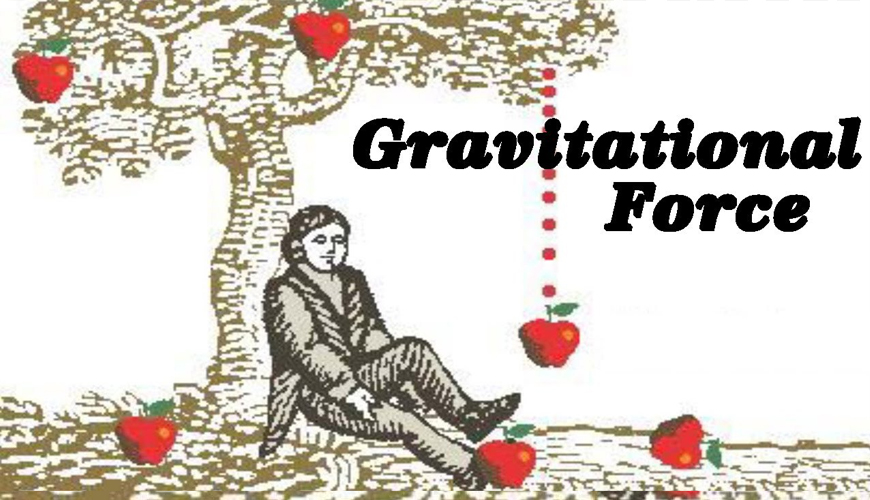
Universal Law of Gravitation
→ Sir Isaac Newton in 1687 proposed a law about the force of attraction between the
objects in the universe which is known as Newton’s law of gravitation.
According to Universal law of Gravitation
→ Every mass in this universe attracts every other mass with a force which is directly proportional to
the product of two masses and inversely proportional to the square of the distance between them
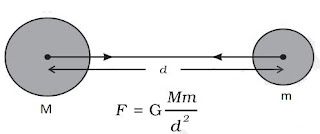
• Let masses (M) and (m) of two objects are distance (d) apart, then force of attraction (F) between
them
F ∝ M×m
F ∝ 1/d2
F ∝ Mm/d2
F = (GMm)/d2
where,
G is a constant and is known as Gravitational constant.
Value of G = 6.67×10-11 Nm2/kg2
G is called universal gravitational constant.
→ If unit of F is in Newton, m is in kg, d is in mere, then unit of G can be calculated as :
G = (F×d2)/Mm, therefor unit will be Nm2/kg2
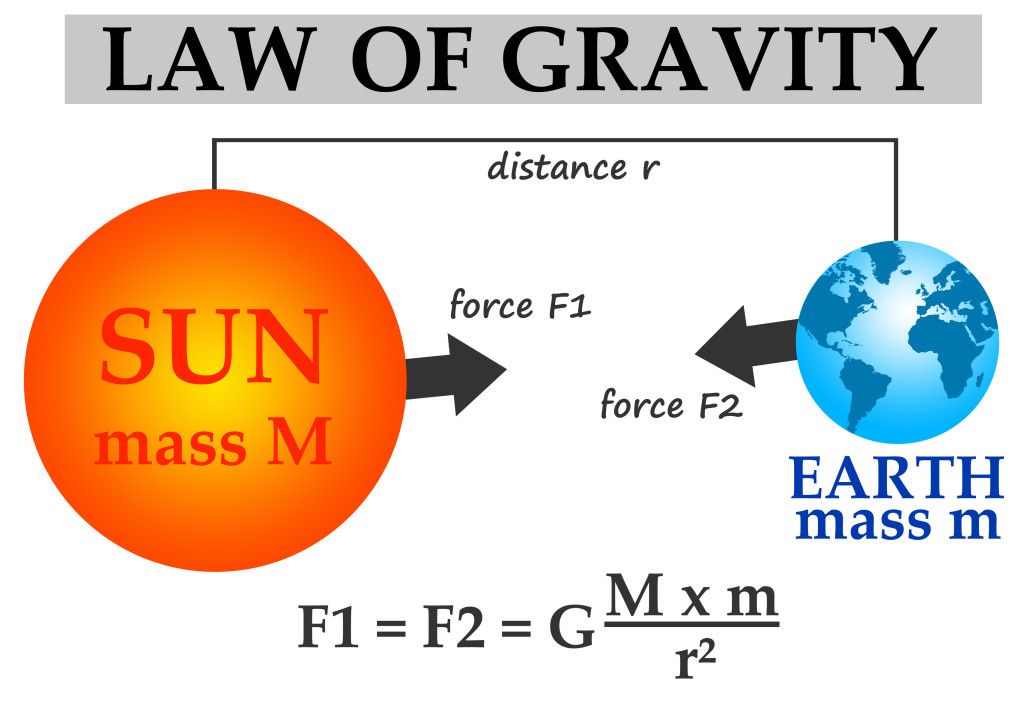
Importance of universal law of gravitation
(i) The force that binds us to the earth.
(ii) The motion of moon around the earth.
(iii) The motion of earth around the sun.
(iv) The tides due to moon and the sun.
1. Introduction
Chapter 10
Gravitation
Introduction
Gravitational force of Earth:
- If we release a small stone without pushing it from a height it accelerates towards Earth. The stone is when accelerated towards earth, means some force is acting on it.
- The force which pulls the object towards the centre of earth is known as gravitational force of the earth. Here, stone also attracts the earth.
- It means every object in universe attracts every other object.
- When a body undergoes circular motion, it experiences a force that acts towards the centre of the circle. This centre-seeking force is called a centripetal force.
Universal Law of Gravitation
- According to the universal law of gravitation, every object attracts every other object with a force.
- This force is directly proportional to the product of their masses.
- This force is inversely proportional to the square of distances between them.
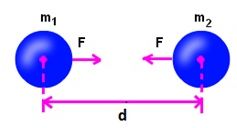
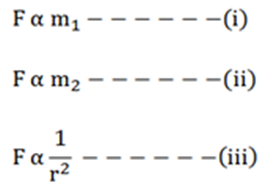
From the above equation we can rewrite them as the following:
![]()
If we remove the proportionality, we get proportionality constant G as the following:
![]()
According to, Newton’s universal Law of gravitation
G = Fr2/ m1 m2
SI Unit: Nm2 kg-2
Value of G = 6.673 × 10-11 Nm2 kg-2
The proportionality constant G is also known as the Universal Gravitational Constant.
Importance of universal law of gravitation
It explains:
- the force that binds us to the earth.
- the motion of moon around the earth
- the motion of planets around the sun.
- the tides due to the moon and the sun.
2. Gravitational Constant and its Units
- Books Name
- Science Made Easy Science Book
- Publication
- Science Made Easy
- Course
- CBSE Class 9
- Subject
- Science
Free fall of an object and acceleration (g)
→ When an object is thrown upward, it reaches certain height, then it starts falling down towar
earth. It is because the earth’s gravitational force exerts on it.
→ This fall under the influence of earth is called ‘free fall of an object’.

→ During this free fall direction do not change but velocity continuously changes which is calle
acceleration due to gravity. It is denoted by ‘g’.
→ Its unit is same as acceleration m/s .
2. Gravitational Constant and its Units
Freefall
• When an object falls down towards the earth under the gravitational force alone, we say the object is in free fall.
• The velocity of a freely falling body changes and is said to be accelerated.
• This acceleration is called acceleration due to gravity, denoted by ’g’. Unit is m/s2.
• The motion of objects under the influence of gravity ‘g’ does not depend on the mass of the body. All objects fall at the same rate.
We know that, F= ma
Therefore, F = mg
The force (F) of gravitational attraction on a body of mass m due to earth of mass M and radius R is given by
![]()
g. But the acceleration due to gravity is represented by the symbol g. Therefore, we can write
h. F = mg ... (2)
i. From the equation (1) and (2), we get
![]()
j. When body is at a distance ‘r’ from the centre of the earth then
![]()
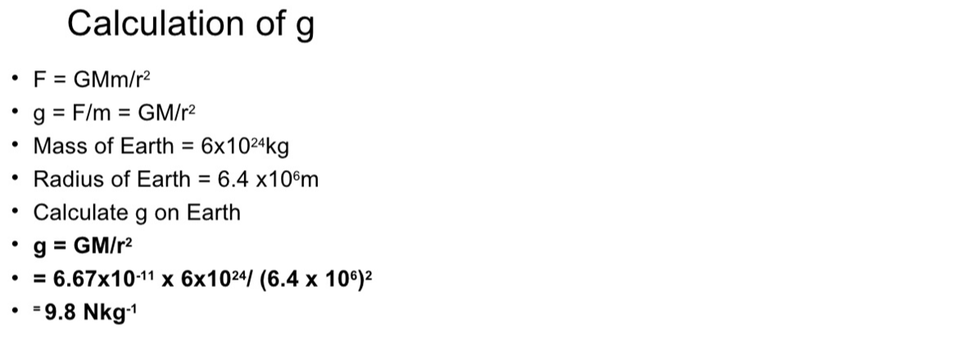
Weight of object on the moon
Just like the Earth, the Moon also exerts a force upon objects. Hence, objects on moon also have some weight. The weight will not be same as than on the earth. So, weight on the Moon can be calculated as -
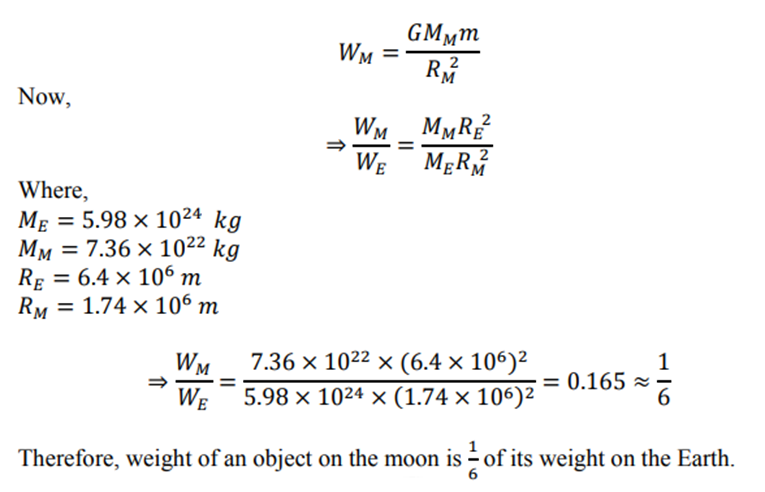
3. Weight and Mass
- Books Name
- Science Made Easy Science Book
- Publication
- Science Made Easy
- Course
- CBSE Class 9
- Subject
- Science
Gravitational Acceleration and its value at the surface of earth
→ The uniform acceleration produced in a freely falling object due to the gravitational force of
earth, is called acceleration due to gravity.
→ It is represented by ‘g’ and it always acts towards the centre of the earth.
Mathematical Expression for g
From the second law of motion, force is the product of mass and acceleration.
F = ma
For free fall, acceleration is replaced by acceleration due to gravity.
Therefore, force becomes:
F = mg ….(i)
But from Universal Law of Gravitation,
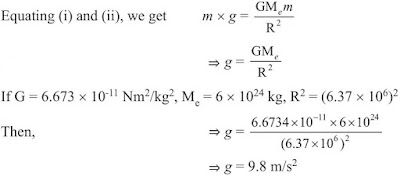
Factors Affecting the Value of g
- As the radius of the earth increases from the poles to the equator, the value of g becomes greater at the poles than at the equator.
- As we go at large heights, value of g decreases.
To Calculate the Value of g
Value of universal gravitational constant, G = 6.7 × 10–11 N m2/ kg2,
Mass of the earth, M = 6 × 1024 kg, and
Radius of the earth, R = 6.4 × 106 m
Putting all these values in equation (iii), we get:

Thus, the value of acceleration due to gravity of the earth, g = 9.8 m/s2.
3. Weight and Mass
Mass:
• Mass of an object is the measure of its inertia.
• It is the matter present in it. It remains the same everywhere in the universe.
Weight:
• The force of attraction of the earth on the object is known as the weight of the object.
• It’s S.I. unit is Newton.
W = m x g
Thrust:
• The force that acts in the perpendicular direction is called thrust.
• It is similar to force applied to an object
• It is a vector quantity.
Pressure
• The force that acts per unit area of the object is pressure.
• It is the thrust per unit area.
• Pressure is denoted by ‘P'
• P = thrust/ area = force/ area = F/A
• SI unit: N/m2 or Pa (Pascal)
Applications of pressure
• The base of high buildings is made wider so that weight of the walls act over a large surface area and pressure is less.
• School bags are having broad strap so that the weight of the school bags fall over a large area of shoulder and produce less pressure and become less painful.
• All liquids and gases exist pressure in all direction.
4. Buoyancy and Density
- Books Name
- Science Made Easy Science Book
- Publication
- Science Made Easy
- Course
- CBSE Class 9
- Subject
- Science
Difference between Gravitation Constant (G) and Gravitational Acceleration (g)
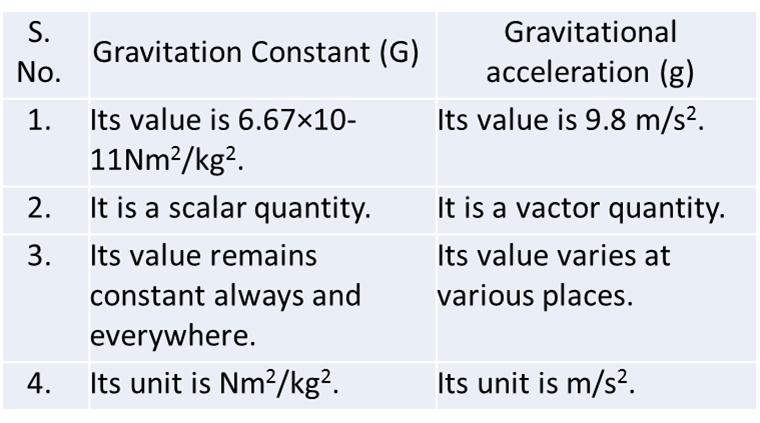
Motion of Objects Under the Influence of Gravitational Force of the Earth
Let an object is falling towards earth with initial velocity u. Let its velocity, under the effect of gravitational acceleration g, changes to v after covering the height h in time t.
Then the three equations of motion can be represented as:
Velocity (v) after t seconds, v = u + ght
Height covered in t seconds, h = ut + ½gt2
Relation between v and u excluding t, v2 = u2 + 2gh
The value of g is taken as positive in case of the object is moving towards earth and taken as negative in case of the object is thrown in opposite direction of the earth.
4. Buoyancy and Density
Buoyancy
• Whenever an object is immersed in a liquid, the liquid exerts a buoyant force or upthrust in the opposite direction of the gravitational force. This is also called the Force of Buoyancy.
• It depends upon the density of the fluid.
• Therefore, an object is able to float in water when the gravitational force is less than the buoyant force.
• Similarly, an object sinks into the water when the gravitational force is larger than the buoyant force.
Archimedes principle
• According to the Archimedes principle, whenever an object is immersed in a liquid (fully or partially), the liquid exerts an upward force upon the object. The amount of that force is equivalent to the weight of the liquid displaced by the object.
Why does an object sink or float on water?
• An object can sink or float on water based on its density with respect to water. The density is defined as mass per unit volume.
• Objects having a density less than water float in it. For Example, Cork flows in water because its density is lower than that of water.
• Objects that have a density higher than water sink in it. For Example, Iron nail sinks in water because the density of iron is more than water's density.
Thus, we can conclude that buoyancy depends upon:
The density of the liquid
The volume of the object (as the volume of object increases, its density decreases and vice-versa
Application of Archimedes Principle:
• In evaluating relative density
• In designing ships and submarines
• In making lactometers and hydrometers
Relative Density

MOTION OF OBJECT UNDER GRAVITY
- Books Name
- Science Made Easy Science Book
- Publication
- Science Made Easy
- Course
- CBSE Class 9
- Subject
- Science
Motion of Objects Under the Influence of Gravitational Force of the Earth
Let an object is falling towards earth with initial velocity u. Let its velocity, under the effect of gravitational acceleration g, changes to v after covering the height h in time t.
Then the three equations of motion can be represented as:
Velocity (v) after t seconds, v = u + ght
Height covered in t seconds, h = ut + ½gt2
Relation between v and u excluding t, v2 = u2 + 2gh
The value of g is taken as positive in case of the object is moving towards earth and taken as negative in case of the object is thrown in opposite direction of the earth.
5. Archimedes'S Principle
- Books Name
- Science Made Easy Science Book
- Publication
- Science Made Easy
- Course
- CBSE Class 9
- Subject
- Science
Mass & weight
Mass (m)
- The mass of a body is the quantity of matter contained in it.
- Mass is a scalar quantity which has only magnitude but no direction.
- Mass of a body always remains constant and does not change from place to place.
- SI unit of mass is kilogram (kg).
- Mass of a body can never be zero.
Weight (W)
- The force with which an object is attracted towards the centre of the earth, is called the weight of the object.
Now, Force =m×a
But in case of earth,a=g
∴F=m×g
But the force of attraction of earth on an object is called its weight (W).
∴W=mg - As weight always acts vertically downwards, therefore, weight has both magnitude and direction and thus it is a vector quantity.
- The weight of a body changes from place to place, depending on mass of object.
- The SI unit of weight is Newton.
- Weight of the object becomes zero if g is zero.
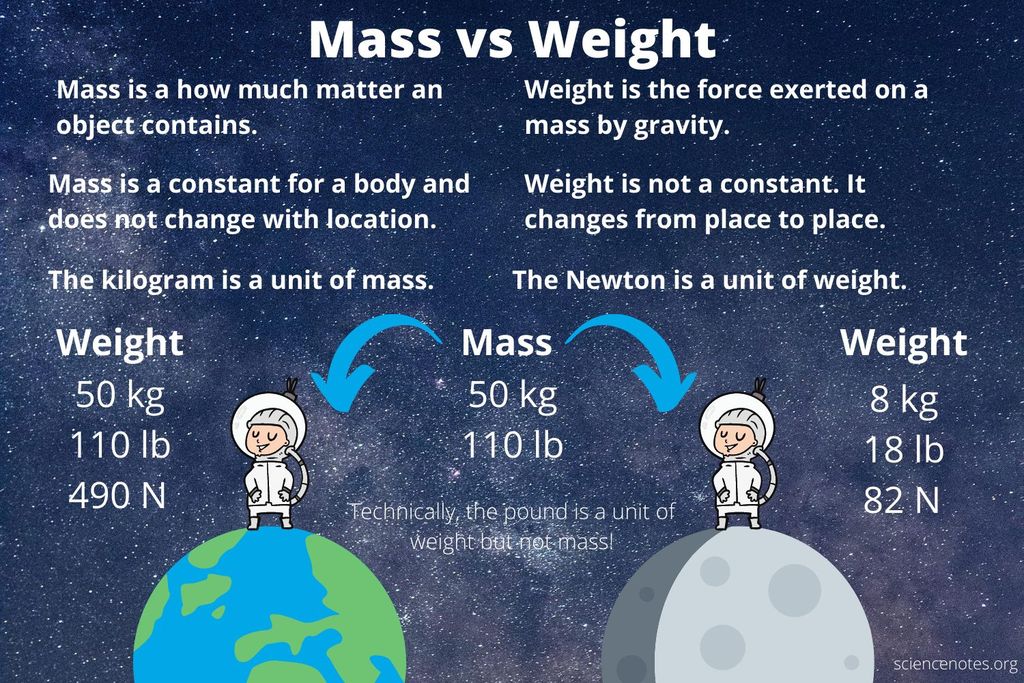
Weight of an Object on the Surface of Moon
Mass of an object is same on earth as well as on moon. But weight is different.
weight of the object on the moon = (1/6) × its weight on the earth.

 Science Made Easy
Science Made Easy
